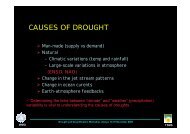training course on weather radar systems - RTC, Regional Training ...
training course on weather radar systems - RTC, Regional Training ...
training course on weather radar systems - RTC, Regional Training ...
- No tags were found...
You also want an ePaper? Increase the reach of your titles
YUMPU automatically turns print PDFs into web optimized ePapers that Google loves.
MODULE A- INTRODUCTION TO RADAR<br />
The <strong>radar</strong> bands located in the spectrum have been designated by certain letters as follows:<br />
Band Designati<strong>on</strong> Nominal Frequency Nominal Wavelength<br />
HF 3-30 MHz 100-10 m<br />
VHF 30-300 MHz 10-1 m<br />
UHF 300-1000 MHz 1-0.3 m<br />
L 1-2 GHz 30-15 cm<br />
S 2-4 GHz 15-8 cm<br />
C 4-8 GHz 8-4 cm<br />
X 8-12 GHz 4-2.5 cm<br />
Ku 12-18 GHz 2.5-1.7 cm<br />
K 18-27 GHz 1.7-1.2 cm<br />
Ka 27-40 GHz 1.2-0.75 cm<br />
V 40-75 GHz 0.75-0.40 cm<br />
W 75-110 GHz 0.40-0.27 cm<br />
mm 110-300 GHz 0.27-0.1 cm<br />
Specific frequencies within above ranges have been assigned for <strong>radar</strong>s by Internati<strong>on</strong>al<br />
Telecommunicati<strong>on</strong> Uni<strong>on</strong> (ITU). The radio frequency bands used by <strong>weather</strong> <strong>radar</strong>s are located<br />
around 2.8 GHz (S-Band), 5.6 GHz (C-Band), 9.4 GHz (X-Band) and 35.6 GHz (Ka-Band).<br />
3. 2. Electromagnetic waves<br />
Electromagnetic or radio waves c<strong>on</strong>sist of electric (E) and magnetic (H) force fields, which are<br />
perpendicular to each other and to the directi<strong>on</strong> of propagati<strong>on</strong> of the wave fr<strong>on</strong>t, propagate<br />
through space at the speed of light and interact with matter al<strong>on</strong>g their paths. These waves have<br />
sinusoidal spatial and temporal variati<strong>on</strong>s. The distance or time between successive wave peaks<br />
(or other reference points) of the electric (magnetic) force defines the wavelength λ or wave<br />
period T. These two important electromagnetic field parameters are related to the speed of light<br />
c. The wave period T is the reciprocal of the frequency f. Frequency refers to the number of<br />
completed wave cycles per sec<strong>on</strong>d. Radar frequency is expressed in units of Hertz (Hz). Higher<br />
frequency transmitters produce shorter wavelengths and vice versa. Wave amplitude is simply<br />
28<br />
TURKEY RADAR TRAINING 1.0 / ALANYA 2005
















